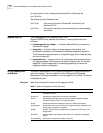
Backing Up the Software 65
If bcmdiagnose shows a failure, check the SNMP read/write community string for
FTP/TFTP file transfer permissions.
Backing Up the Software
To back up your software to an NMS, use:
bcmbackup [both | primary | secondary] [-name:<backname>]<device>]
Values
Directory Paths All backups and upgrades use the following directory paths.
For UNIX:
/tftpboot/CLIENTS/<mac_address>/bcm/<backname><directory name on
bridge/router>/
For example:
/tftpboot/CLIENTS/0800020A399E/bcm/name/primary/
For Windows:
\%tftpboot%\CLIENTS\<mac_address>\bcm\<backname>\<directory name on
bridge/router>\
For example:
\tftpboot\CLIENTS\0800020A399E\bcm\name\primary\
Values
both Backs up both the primary and secondary boot source. This
value is the default.
primary Backs up the primary boot source.
secondary Backs up the secondary boot source.
<backname> Specifies the name of the backup for the boot blocks.
<device> The IP address or hostname of the bridge/router.
tftpboot For UNIX: Directory specified in inetd or tftpd for tftpd files.
%tftpboot% For Windows (using the default 3Com TFTP server): Directory
specified in the Win.ini file in the “[3Com.nm] TFTPROOT=”
section. The Win.ini file is located in the default Windows
directory, for example C:\windows or C:\winnt4.
CLIENTS Name of the directory.
<mac_ address> The MAC address of the bridge/router or switch.
<directory name
on bridge/router>
The name of the boot directory on the bridge/router or
switch. If the primary boot source is set to “/,” the name of
the current version of software is used instead. If the
secondary boot source is set to “/,” then the directory is
called “secondar”.


















